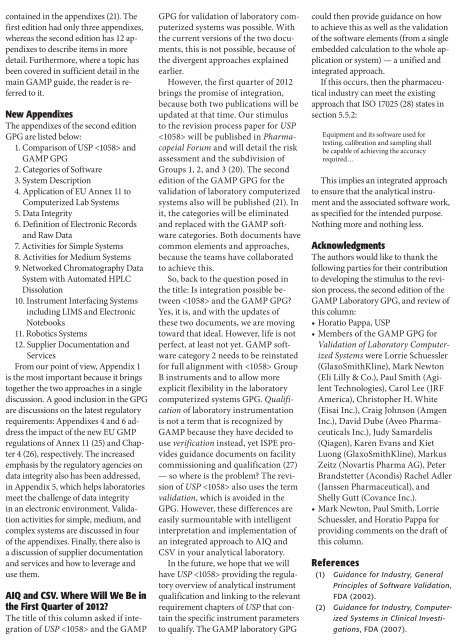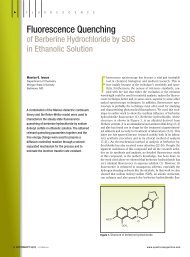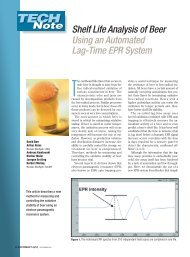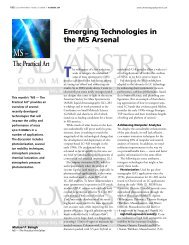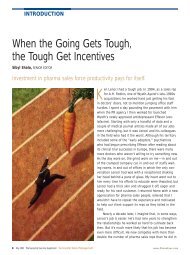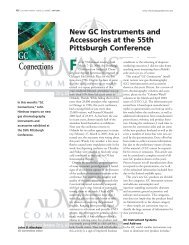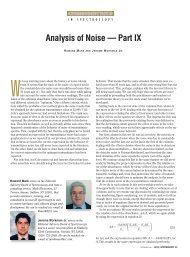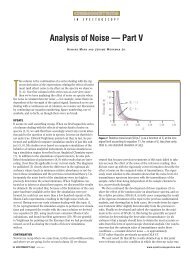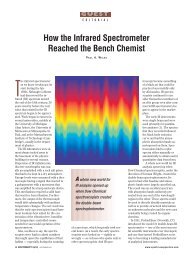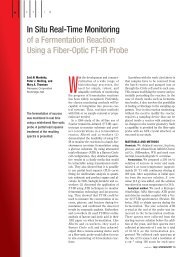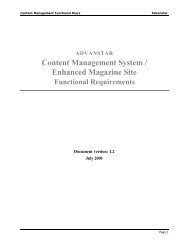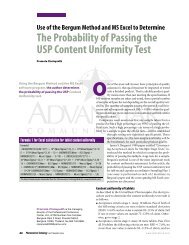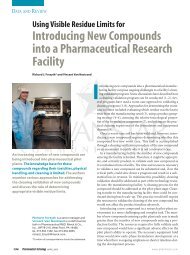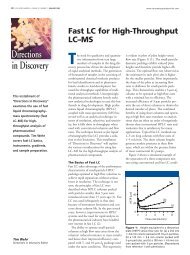2012 Corporate Capabilities - Spectroscopy
2012 Corporate Capabilities - Spectroscopy
2012 Corporate Capabilities - Spectroscopy
You also want an ePaper? Increase the reach of your titles
YUMPU automatically turns print PDFs into web optimized ePapers that Google loves.
www.spectroscopyonline.com<br />
December 2011 <strong>Spectroscopy</strong> 26(12) 19<br />
contained in the appendixes (21). The<br />
first edition had only three appendixes,<br />
whereas the second edition has 12 appendixes<br />
to describe items in more<br />
detail. Furthermore, where a topic has<br />
been covered in sufficient detail in the<br />
main GAMP guide, the reader is referred<br />
to it.<br />
New Appendixes<br />
The appendixes of the second edition<br />
GPG are listed below:<br />
1. Comparison of USP and<br />
GAMP GPG<br />
2. Categories of Software<br />
3. System Description<br />
4. Application of EU Annex 11 to<br />
Computerized Lab Systems<br />
5. Data Integrity<br />
6. Definition of Electronic Records<br />
and Raw Data<br />
7. Activities for Simple Systems<br />
8. Activities for Medium Systems<br />
9. Networked Chromatography Data<br />
System with Automated HPLC<br />
Dissolution<br />
10. Instrument Interfacing Systems<br />
including LIMS and Electronic<br />
Notebooks<br />
11. Robotics Systems<br />
12. Supplier Documentation and<br />
Services<br />
From our point of view, Appendix 1<br />
is the most important because it brings<br />
together the two approaches in a single<br />
discussion. A good inclusion in the GPG<br />
are discussions on the latest regulatory<br />
requirements: Appendixes 4 and 6 address<br />
the impact of the new EU GMP<br />
regulations of Annex 11 (25) and Chapter<br />
4 (26), respectively. The increased<br />
emphasis by the regulatory agencies on<br />
data integrity also has been addressed,<br />
in Appendix 5, which helps laboratories<br />
meet the challenge of data integrity<br />
in an electronic environment. Validation<br />
activities for simple, medium, and<br />
complex systems are discussed in four<br />
of the appendixes. Finally, there also is<br />
a discussion of supplier documentation<br />
and services and how to leverage and<br />
use them.<br />
AIQ and CSV. Where Will We Be in<br />
the First Quarter of <strong>2012</strong>?<br />
The title of this column asked if integration<br />
of USP and the GAMP<br />
GPG for validation of laboratory computerized<br />
systems was possible. With<br />
the current versions of the two documents,<br />
this is not possible, because of<br />
the divergent approaches explained<br />
earlier.<br />
However, the first quarter of <strong>2012</strong><br />
brings the promise of integration,<br />
because both two publications will be<br />
updated at that time. Our stimulus<br />
to the revision process paper for USP<br />
will be published in Pharmacopeial<br />
Forum and will detail the risk<br />
assessment and the subdivision of<br />
Groups 1, 2, and 3 (20). The second<br />
edition of the GAMP GPG for the<br />
validation of laboratory computerized<br />
systems also will be published (21). In<br />
it, the categories will be eliminated<br />
and replaced with the GAMP software<br />
categories. Both documents have<br />
common elements and approaches,<br />
because the teams have collaborated<br />
to achieve this.<br />
So, back to the question posed in<br />
the title: Is integration possible between<br />
and the GAMP GPG?<br />
Yes, it is, and with the updates of<br />
these two documents, we are moving<br />
toward that ideal. However, life is not<br />
perfect, at least not yet. GAMP software<br />
category 2 needs to be reinstated<br />
for full alignment with Group<br />
B instruments and to allow more<br />
explicit flexibility in the laboratory<br />
computerized systems GPG. Qualification<br />
of laboratory instrumentation<br />
is not a term that is recognized by<br />
GAMP because they have decided to<br />
use verification instead, yet ISPE provides<br />
guidance documents on facility<br />
commissioning and qualification (27)<br />
— so where is the problem? The revision<br />
of USP also uses the term<br />
validation, which is avoided in the<br />
GPG. However, these differences are<br />
easily surmountable with intelligent<br />
interpretation and implementation of<br />
an integrated approach to AIQ and<br />
CSV in your analytical laboratory.<br />
In the future, we hope that we will<br />
have USP providing the regulatory<br />
overview of analytical instrument<br />
qualification and linking to the relevant<br />
requirement chapters of USP that contain<br />
the specific instrument parameters<br />
to qualify. The GAMP laboratory GPG<br />
could then provide guidance on how<br />
to achieve this as well as the validation<br />
of the software elements (from a single<br />
embedded calculation to the whole application<br />
or system) — a unified and<br />
integrated approach.<br />
If this occurs, then the pharmaceutical<br />
industry can meet the existing<br />
approach that ISO 17025 (28) states in<br />
section 5.5.2:<br />
Equipment and its software used for<br />
testing, calibration and sampling shall<br />
be capable of achieving the accuracy<br />
required…<br />
This implies an integrated approach<br />
to ensure that the analytical instrument<br />
and the associated software work,<br />
as specified for the intended purpose.<br />
Nothing more and nothing less.<br />
Acknowledgments<br />
The authors would like to thank the<br />
following parties for their contribution<br />
to developing the stimulus to the revision<br />
process, the second edition of the<br />
GAMP Laboratory GPG, and review of<br />
this column:<br />
• Horatio Pappa, USP<br />
• Members of the GAMP GPG for<br />
Validation of Laboratory Computerized<br />
Systems were Lorrie Schuessler<br />
(GlaxoSmithKline), Mark Newton<br />
(Eli Lilly & Co.), Paul Smith (Agilent<br />
Technologies), Carol Lee (JRF<br />
America), Christopher H. White<br />
(Eisai Inc.), Craig Johnson (Amgen<br />
Inc.), David Dube (Aveo Pharmaceuticals<br />
Inc.), Judy Samardelis<br />
(Qiagen), Karen Evans and Kiet<br />
Luong (GlaxoSmithKline), Markus<br />
Zeitz (Novartis Pharma AG), Peter<br />
Brandstetter (Acondis) Rachel Adler<br />
(Janssen Pharmaceutical), and<br />
Shelly Gutt (Covance Inc.).<br />
• Mark Newton, Paul Smith, Lorrie<br />
Schuessler, and Horatio Pappa for<br />
providing comments on the draft of<br />
this column.<br />
References<br />
(1) Guidance for Industry, General<br />
Principles of Software Validation,<br />
FDA (2002).<br />
(2) Guidance for Industry, Computerized<br />
Systems in Clinical Investigations,<br />
FDA (2007).


